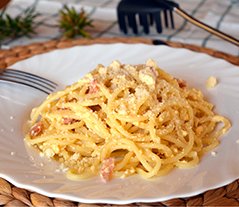 Pasta is one of the most worshipped meals in Italy. Easy to prepare, healthy and one of the specialities of the “Nonna” or “Mamma”, Italy’s unofficial pasta masters. The more you travel through Italy, the more you realize how many different kinds and varieties of pastas are available in every different region. Carbonara is well known all over the world and it is one of the essential dishes of Lazio and Abruzzo food culture.
Pasta is one of the most worshipped meals in Italy. Easy to prepare, healthy and one of the specialities of the “Nonna” or “Mamma”, Italy’s unofficial pasta masters. The more you travel through Italy, the more you realize how many different kinds and varieties of pastas are available in every different region. Carbonara is well known all over the world and it is one of the essential dishes of Lazio and Abruzzo food culture.
As you probably may guess, everything that is related to food is taken very seriously in Italy. For this reason, talking about the origins of a Carbonara is a very “dangerous” subject. Generally, Carbonara could be a synonym of Lazio and its surroundings, but there is a one of a kind debate about its real heritage. Some say that Carbonara is a delicacy that has its birthplace in Polesine (Rovigo) in the northern part of Italy, because according to this version, it was the main dish of the secret sect of “Carboneria”. Others, support that this meal derives from a reinterpretation of a typical food of the Slovenian cuisine. Another theory is that Carbonara came from the Neapolitan cuisine and its traces can be found in a specific recipe book. But, the most fascinating story is the one recounting a strong US-British influence on the genesis of this variety of pasta. This captivating tale is based on two main facts: first, there is no trace of this dish in any of the historic recipe books before 1944, and second, during that period the US and British forces were in massive presence all over Italy, Rome in particular, and the eggs and bacon were two of the major staples of their diet.
Obviously, every Roman strongly refuses each of these versions. The tradition speaks clear, the pasta Carbonara is an evolution of “Cace e Ova”, a pasta that coalmen (Carbonari) brought in their pockets and ate cold with their bare hands. By the way, forks and knives in the early 1900s were a luxury. So, when two main ingredients, fresh ground black pepper and pieces of “guanciale”, were added, the “Cace and Ova” became the “Carbonara” thanks to the simple way of living of the coalman. To this day, this recipe has a heritage that is jealously guarded by every Roman grandmother.
We talked too much about stories, let’s check the ingredients! So, the very real Carbonara needs: spaghetti, eggs, freshly ground black pepper, guanciale and pecorino. You have to pick a long type of pasta, Spaghetti are on the recipe books but some variations are possible like Linguine and Bucatini. Your eggs have to be farmed fresh. Your Black Pepper has to be freshly ground on your beaten eggs but also on the pasta just right before you eat it. Then there are the two exclamation points to the ingredients list. First, the so called “Guanciale”, pork jowls that are seasoned and cured for at least three months resulting in a more intense flavor than the “pancetta” bacon that is commonly considered part of the original recipe. Second, the Pecorino cheese is a must, grated over the beaten eggs with black pepper, but also sprinkled on top at the last moment when you’re not really able to keep the fork away from the dish. Parmigiano could be a variation but the taste would not be the same.
After all this, we’ll not speak about the preparation, simply because you really need to go and taste a real carbonara in Lazio and Abruzzo. There, this delicious and flavorful pasta is made with passion and pride, respecting the original recipe which makes this delicacy one of the most copied, without success, pastas in the world.